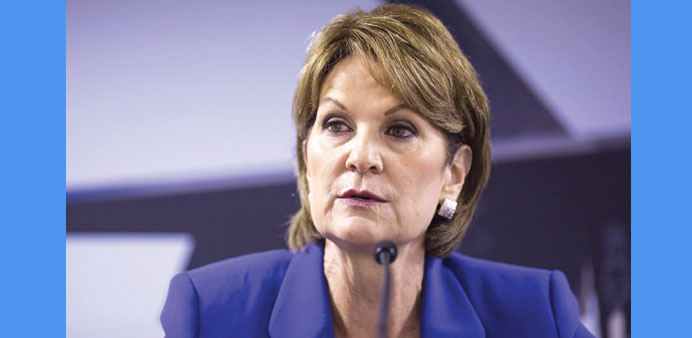Over the past 18 months, Lockheed Martin Corp CEO Marillyn Hewson has grown more assertive, her power buoyed by a powerful share price rally that has earned her the respect of her board and key shareholders.
Reuters/Washington
Lockheed Martin Corp’s decision to buy helicopter maker Sikorsky Aircraft and sell $6bn in lower-margin units marks a clear turning point for Lockheed CEO Marillyn Hewson, who is shaking up the world’s largest weapons maker.
Thrust into the CEO job in January 2013 after retiring CEO Robert Stevens’ designated successor was fired for having an affair with a subordinate, Hewson spent her first year largely executing a strategy Stevens had mapped out and repairing tense ties with the Pentagon on the $391bn F-35 fighter programme.
Over the past 18 months, the seemingly mild-mannered engineer who is ranked No 4 on Fortune’s list of most powerful US women executives, has grown more assertive, her power buoyed by a powerful share price rally that has earned her the respect of her board and key shareholders.
“It’s a great story. The accidental CEO steps in, doubles the share price, raises margins and then executes the biggest M&A deal the company has done in two decades,” said one industry executive familiar with Hewson’s career. “But remember, the higher you aim, the greater the crash if things don’t work out.”
Indeed, the Sikorsky acquisition could test the 61-year-old executive’s legacy of pleasing investors by running a tight ship.
Industry executives said Hewson’s track record of cutting costs — she pared the company’s workforce by 8,000 people, or 6.7%, closed facilities and streamlined its structure — helped her convince Lockheed’s generally conservative board to make a bet on the helicopter maker.
That may not have been an easy call given a market downturn and uncertain outlook for near-term military sales. To seal the takeover of the unit that United Technologies Corp unloaded because of its narrow margins, Lockheed agreed to pay a premium $9bn for a company projecting revenues of just $6.5bn.
A 30-year veteran of Lockheed, Hewson has focused on long-term investments, like “over the horizon” projects such as work on a portable fusion energy reactor, where she has channelled some savings from the recent cost cuts.
In February, she told reporters that companies needed to “see the big picture” on challenges such climate change, energy and other national security threats.
Her legacy and the future outlook of the Pentagon’s biggest supplier will be shaped by Lockheed’s ability to integrate Sikorsky, offload its services business, and keep key programmes like the F-35 and Sikorsky’s presidential helicopter on track. Officials are also anxiously awaiting the outcome of two military competitions — a new Air Force bomber valued at over $80bn for which Lockheed is teamed with Boeing Co, and a multibillion-dollar ground vehicle competition to replace tens of thousands of military vehicles.
“These deals are critical to helping her solidify her personal leadership since Lockheed has been heavily focused in recent years on share repurchases, dividends and turning F-35 around,” said Jim McAleese, a Virginia-based defense consultant.
Sikorsky is Lockheed’s biggest takeover since it bought Loral Corp’s defense electronics business for $9.1bn in 1996, and is just shy of the $10bn merger with Martin Marietta in 1994 that created the company as it stands today.
An executive at another firm that looked at buying Sikorsky cautioned that the deal is not without risks, given the threat of further defense budget cuts, issues with several helicopter development programmes, and overall cost of the deal.
Lockheed would also face difficult contract negotiations in coming years with Sikorsky’s unions.
Still, Hewson was intent on adding another “signature” product line to help balance the company’s portfolio, which is growing increasingly dependent on the F-35, according to sources familiar with the company. She had Sikorsky “in her sights” after her days working on the MH-60R and MH60S helicopters the two company co-produce for the Navy.
Beyond the risks in Sikorsky, losing either one of the big weapons programmes on the table would also be a big setback given how much the company has invested in both, analysts said.
Executives who have worked closely with Hewson describe her as tough and detail-oriented, someone who demands a lot of herself and others around her. An early riser who dashes off e-mails well before dawn, Hewson is not someone prone to fly off the handle when something goes wrong, associates say.
Married and the mother of two grown sons, Hewson promotes diversity programmes within the company and writes a regular blog for networking site LinkedIn. She also often brings in writers like The Tipping Point author Malcolm Gladwell to explore new ideas and stimulate conversations with her leadership team.
In a May LinkedIn posting, Hewson drew on her own experience to urge workers to push themselves beyond their comfort zone.
“Don’t limit yourself by doubting your ability to step up to a challenge ... Take advantage of the growth opportunities that come your way - even if they might seem like a reach,” she said, adding, “results matter.”

